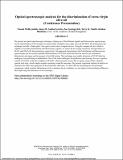Files in this item
Optical spectroscopic analysis for the discrimination of extra-virgin olive-oil
Item metadata
| dc.contributor.author | McReynolds, Naomi | |
| dc.contributor.author | Garcia, Juan M. Aunon | |
| dc.contributor.author | Guengerich, Zoe | |
| dc.contributor.author | Smith, Terry K. | |
| dc.contributor.author | Dholakia, Kishan | |
| dc.contributor.editor | Piyawattanametha, W | |
| dc.contributor.editor | Park, YH | |
| dc.date.accessioned | 2017-08-29T14:30:06Z | |
| dc.date.available | 2017-08-29T14:30:06Z | |
| dc.date.issued | 2017-01-28 | |
| dc.identifier | 250569193 | |
| dc.identifier | 0a993804-00ca-4186-b80f-9530ca0ac4d8 | |
| dc.identifier | 000404905500019 | |
| dc.identifier | 000404905500019 | |
| dc.identifier.citation | McReynolds , N , Garcia , J M A , Guengerich , Z , Smith , T K & Dholakia , K 2017 , Optical spectroscopic analysis for the discrimination of extra-virgin olive-oil . in W Piyawattanametha & YH Park (eds) , MOEMS AND Miniaturized Systems XVI . , 101160K , Proceedings of SPIE , vol. 10116 , SPIE , Conference on MOEMS and Miniaturized Systems XVI , San Francisco , California , United States , 30/01/17 . https://doi.org/10.1117/12.2250554 | en |
| dc.identifier.citation | conference | en |
| dc.identifier.isbn | 9781510606746 | |
| dc.identifier.issn | 0277-786X | |
| dc.identifier.uri | https://hdl.handle.net/10023/11561 | |
| dc.description.abstract | We present an optical spectroscopic technique, making use of both Raman signals and fluorescence spectroscopy, for the identification of five brands of commercially available extra-virgin olive-oil (EVOO). We demonstrate our technique on both a ‘bulk-optics’ free-space system and a compact device. Using the compact device, which is capable of recording both Raman and fluorescence signals, we achieved an average sensitivity and specificity of 98.4% and 99.6% for discrimination, respectively. Our approach demonstrates that both Raman and fluorescence spectroscopy can be used for portable discrimination of EVOOs which obviates the need to use centralised laboratories and opens up the prospect of in-field testing. This technique may enable detection of EVOO that has undergone counterfeiting or adulteration. One of the main challenges facing Raman spectroscopy for use in quality control of EVOOs is that the oxidation of EVOO, which naturally occurs due to aging, causes shifts in Raman spectra with time, which implies regular retraining would be necessary. We present a potential method of analysis to minimize the effect that aging has on discrimination efficiency; we show that by discarding the first principal component, which contains information on the variations due to oxidation, we can improve discrimination efficiency thus improving the robustness of our technique. © (2017) COPYRIGHT Society of Photo-Optical Instrumentation Engineers (SPIE). Downloading of the abstract is permitted for personal use only. | |
| dc.format.extent | 1 | |
| dc.format.extent | 118582 | |
| dc.language.iso | eng | |
| dc.publisher | SPIE | |
| dc.relation.ispartof | MOEMS AND Miniaturized Systems XVI | en |
| dc.relation.ispartofseries | Proceedings of SPIE | en |
| dc.subject | QH301 Biology | en |
| dc.subject | QC Physics | en |
| dc.subject | DAS | en |
| dc.subject.lcc | QH301 | en |
| dc.subject.lcc | QC | en |
| dc.title | Optical spectroscopic analysis for the discrimination of extra-virgin olive-oil | en |
| dc.type | Conference item | en |
| dc.contributor.institution | University of St Andrews. School of Physics and Astronomy | en |
| dc.contributor.institution | University of St Andrews. School of Biology | en |
| dc.contributor.institution | University of St Andrews. Biomedical Sciences Research Complex | en |
| dc.identifier.doi | https://doi.org/10.1117/12.2250554 |
This item appears in the following Collection(s)
Items in the St Andrews Research Repository are protected by copyright, with all rights reserved, unless otherwise indicated.

